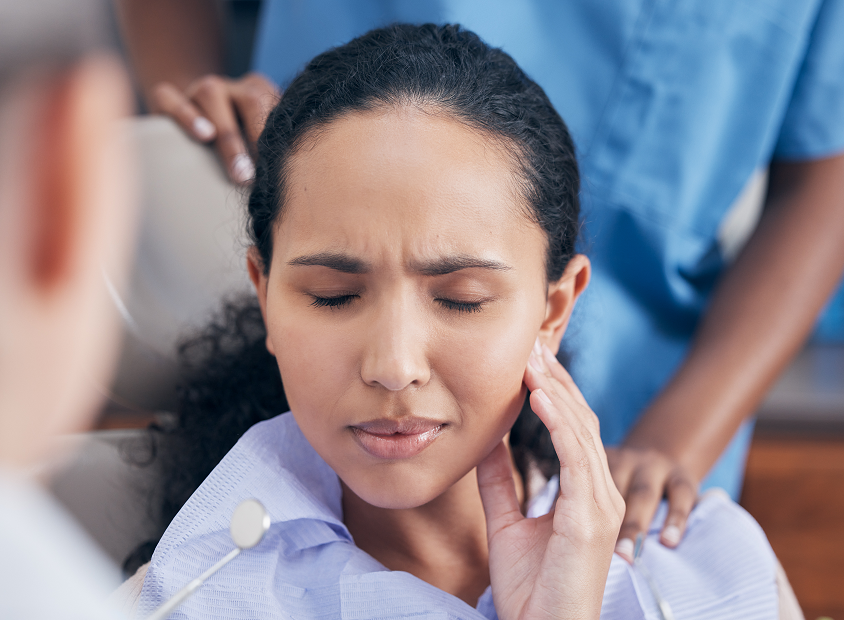
Our mouths are workhorses. They help us speak, chew, and even contribute to facial aesthetics. But just like any other hardworking part of the body, things can go wrong sometimes. Dental emergencies, while not pleasant, are surprisingly common. The good news is that with quick thinking and proper action, you can minimize damage and get the professional help you need to restore your smile. This guide dives into some of the most frequent dental emergencies, explains what might be causing them, and outlines the treatment options your dentist might recommend. We’ll also cover some helpful first-aid tips to manage the situation until you can get to the dentist’s chair.
Toothache Troubles
Toothaches are a surefire sign that something’s amiss. The cause can range from a cavity to a gum infection, but regardless of the culprit, a throbbing or aching tooth is a call to action.
Treatment: Your dentist will diagnose the underlying cause of the toothache and recommend the best course of action. This might involve a filling, root canal, or extraction, depending on the severity of the problem.
First-Aid Tips: Over-the-counter pain relievers like ibuprofen or acetaminophen can offer temporary relief. Rinsing your mouth with warm salt water can help reduce inflammation. If there’s any swelling, apply a cold compress to the outside of your cheek.
Cracked or Chipped Teeth
Whether you bit down on something unexpectedly hard or suffered a minor blow to the face, a chipped or cracked tooth can be a cosmetic concern and sometimes cause sensitivity.
Treatment: The treatment for a chipped or cracked tooth depends on the extent of the damage. Minor chips might be smoothed out with polishing. For larger cracks, a filling, crown, or even root canal might be necessary.
First-Aid Tips: If the chip is causing sharp edges, try to cover it with sugar-free gum to prevent further irritation to your tongue or cheek. Locate any broken pieces of the tooth and bring them with you to the dentist’s office.
Knocked-Out Tooth
Knocking out a tooth is a serious dental emergency. However, swift action can significantly increase the chances of saving the tooth.
Treatment: The ideal scenario is to re-implant the tooth back into its socket. Time is crucial, so if you can locate the tooth, try to gently rinse it with milk (not water) and place it back in the socket. If that’s not possible, hold the tooth by the crown (not the root) and store it in milk until you can see your dentist.
First-Aid Tips: Act quickly! The sooner you get to the dentist, the better the chances of saving the tooth.
Lost Filling or Crown
A lost filling or crown can expose sensitive areas of your tooth, leading to pain and discomfort. It can also affect your ability to chew properly.
Treatment: Your dentist will remove any remaining fragments of the filling or crown and create a new one to restore the tooth’s structure and function.
First-Aid Tips: Save the lost filling or crown if you can, and bring it with you to your dentist appointment. In the meantime, try to cover the exposed area with sugar-free gum to prevent further irritation.
Abscess Agony
An abscess is a pus-filled pocket that forms due to a bacterial infection. It’s typically located near the root of a tooth or in the gum tissue. Abscesses are painful and can cause swelling in your face and jaw.
Treatment: Treating an abscess requires prompt attention from your dentist. Antibiotics might be prescribed to fight the infection, and depending on the severity, a root canal or extraction might be necessary to drain the abscess and remove the source of the infection.
First-Aid Tips: Apply a warm compress to the swollen area for temporary relief. Don’t try to pop the abscess yourself, as this can worsen the infection.
Broken Braces
Broken braces, while not a major crisis, can definitely be a nuisance and cause some discomfort. It’s important to know how to handle the situation to minimize disruption to your orthodontic progress and keep your mouth comfortable. Don’t Panic! Broken braces are a common occurrence and can usually be easily fixed by your orthodontist.
Temporary relief measures: If a wire is poking out and irritating your mouth, try gently pushing it back into place with the eraser end of a pencil or a cotton swab. Use orthodontic wax, available at most drugstores, to cover any sharp edges of the broken bracket or wire. This will help to prevent further irritation.
Being aware of common dental emergencies and understanding their treatments is crucial for maintaining good oral health. Prompt action and seeking professional help are key in alleviating pain, preventing further damage, and preserving the health of your teeth and gums. Remember, prevention is always better than cure, so practicing good oral hygiene and scheduling regular dental check-ups can help avoid many dental emergencies altogether. By staying informed and prepared, you can ensure that your smile remains healthy and bright for years to come.

